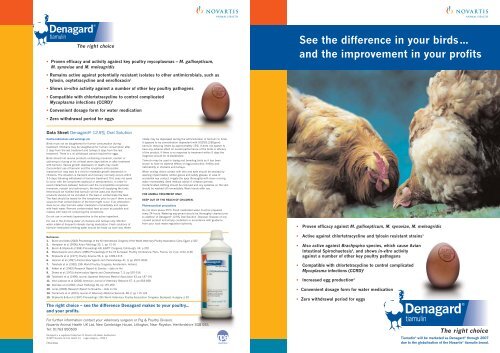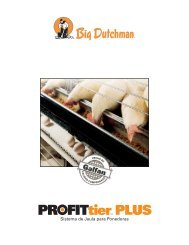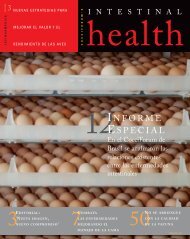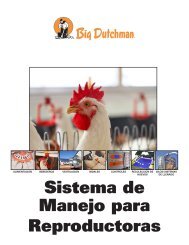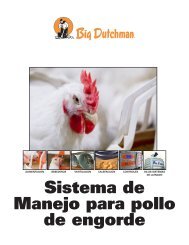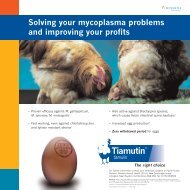The right choice – for Mycoplasmal infections in - The Poultry Site
The right choice – for Mycoplasmal infections in - The Poultry Site
The right choice – for Mycoplasmal infections in - The Poultry Site
You also want an ePaper? Increase the reach of your titles
YUMPU automatically turns print PDFs into web optimized ePapers that Google loves.
14656 PP53 Dena UK <strong>Poultry</strong> Bro AW 8/3/07 1:22 pm Page 1<br />
• Proven efficacy and activity aga<strong>in</strong>st key poultry mycoplasmas <strong>–</strong> M. gallisepticum,<br />
M. synoviae and M. meleagridis<br />
See the difference <strong>in</strong> your birds ...<br />
and the improvement <strong>in</strong> your profits<br />
• Rema<strong>in</strong>s active aga<strong>in</strong>st potentially resistant isolates to other antimicrobials, such as<br />
tylos<strong>in</strong>, oxytetracycl<strong>in</strong>e and enrofloxac<strong>in</strong> 1<br />
• Shows <strong>in</strong>-vitro activity aga<strong>in</strong>st a number of other key poultry pathogens<br />
• Compatible with chlortetracycl<strong>in</strong>e to control complicated<br />
Mycoplasma <strong><strong>in</strong>fections</strong> (CCRD) 3<br />
• Convenient dosage <strong>for</strong>m <strong>for</strong> water medication<br />
• Zero withdrawal period <strong>for</strong> eggs<br />
Data Sheet Denagard ® 12.5% Oral Solution<br />
Contra-<strong>in</strong>dications and warn<strong>in</strong>gs etc<br />
Birds must not be slaughtered <strong>for</strong> human consumption dur<strong>in</strong>g<br />
treatment. Chickens may be slaughtered <strong>for</strong> human consumption after<br />
2 days from the last treatment and turkeys 5 days from the last<br />
treatment. <strong>The</strong>re is a nil withdrawal period required <strong>for</strong> eggs.<br />
Birds should not receive products conta<strong>in</strong><strong>in</strong>g monens<strong>in</strong>, naras<strong>in</strong> or<br />
sal<strong>in</strong>omyc<strong>in</strong> dur<strong>in</strong>g or <strong>for</strong> at least seven days be<strong>for</strong>e or after treatment<br />
with tiamul<strong>in</strong>. Severe growth depression or death may result.<br />
Concomitant use of tiamul<strong>in</strong> and the ionophore anticoccidial<br />
maduramic<strong>in</strong> may lead to a mild to moderate growth depression <strong>in</strong><br />
chickens. <strong>The</strong> situation is transient and recovery normally occurs with<strong>in</strong><br />
3-5 days follow<strong>in</strong>g withdrawal of tiamul<strong>in</strong> treatment. This does not seem<br />
to occur with the ionophores lasalocid or semduramic<strong>in</strong>. In order to<br />
avoid <strong>in</strong>teractions between tiamul<strong>in</strong> and the <strong>in</strong>compatible ionophores<br />
monens<strong>in</strong>, naras<strong>in</strong> and sal<strong>in</strong>omyc<strong>in</strong>, the feed mill supply<strong>in</strong>g the birds<br />
feed should be notified that tiamul<strong>in</strong> will be used and that these<br />
products should not be <strong>in</strong>cluded <strong>in</strong> the feed or contam<strong>in</strong>ate the feed.<br />
<strong>The</strong> feed should be tested <strong>for</strong> the ionophores prior to use if there is any<br />
suspicion that contam<strong>in</strong>ation of the feed might occur. If an <strong>in</strong>teraction<br />
does occur, stop tiamul<strong>in</strong> water medication immediately and replace<br />
with fresh water. Remove contam<strong>in</strong>ated feed as soon as possible and<br />
replace with feed not conta<strong>in</strong><strong>in</strong>g the ionophores.<br />
Do not use <strong>in</strong> animals hypersensitive to the active <strong>in</strong>gredient.<br />
For use <strong>in</strong> the dr<strong>in</strong>k<strong>in</strong>g water of chickens and turkeys only. Monitor<br />
water <strong>in</strong>take at frequent <strong>in</strong>tervals dur<strong>in</strong>g medication. Fresh solutions of<br />
tiamul<strong>in</strong>-medicated dr<strong>in</strong>k<strong>in</strong>g water should be made up each day. Water<br />
<strong>in</strong>take may be depressed dur<strong>in</strong>g the adm<strong>in</strong>istration of tiamul<strong>in</strong> to birds.<br />
It appears to be concentration dependent with 0.025% (250ppm)<br />
tiamul<strong>in</strong> reduc<strong>in</strong>g <strong>in</strong>take by approximately 15%. It does not appear to<br />
have any adverse effect on overall per<strong>for</strong>mance of the birds or efficacy<br />
of the product. If there is no response to treatment with<strong>in</strong> 5 days the<br />
diagnosis should be re-established.<br />
Tiamul<strong>in</strong> may be used <strong>in</strong> lay<strong>in</strong>g and breed<strong>in</strong>g birds as it has been<br />
shown to have no adverse effects on egg production, fertility and<br />
hatchability <strong>in</strong> chickens and turkeys.<br />
When mix<strong>in</strong>g, direct contact with sk<strong>in</strong> and eyes should be avoided by<br />
wear<strong>in</strong>g impermeable rubber gloves and safety glasses. In case of<br />
accidental eye contact, irrigate the eyes thoroughly with clean runn<strong>in</strong>g<br />
water immediately. Seek medical advice if irritation persists.<br />
Contam<strong>in</strong>ated cloth<strong>in</strong>g should be removed and any splashes on the sk<strong>in</strong><br />
should be washed off immediately. Wash hands after use.<br />
FOR ANIMAL TREATMENT ONLY.<br />
KEEP OUT OF THE REACH OF CHILDREN.<br />
Pharmaceutical precautions<br />
Do not store above 25°C. Fresh medicated water must be prepared<br />
every 24 hours. Water<strong>in</strong>g equipment should be thoroughly cleaned prior<br />
to addition of Denagard ® 12.5% Oral Solution. Disposal: Dispose of any<br />
unused product and empty conta<strong>in</strong>ers <strong>in</strong> accordance with guidance<br />
from your local waste regulation authority.<br />
• Proven efficacy aga<strong>in</strong>st M. gallisepticum, M. synoviae, M. meleagridis<br />
Reference:<br />
1. Burch and Valks (2002) Proceed<strong>in</strong>gs of the XII International Congress of the World Veter<strong>in</strong>ary <strong>Poultry</strong> Association, Cairo, Egypt. p 322<br />
2. Hampson et al (2006) Avian Pathology 35, 1, pp 12-16<br />
3. Burch & Stipkovits (1994) Proceed<strong>in</strong>gs 6th EAVPT Congress, Ed<strong>in</strong>burgh, UK. p 202<br />
4. Mazurkiewicz and others (1986) Proceed<strong>in</strong>gs of the VII European <strong>Poultry</strong> Conference, Paris, France. vol 2 pp 1162-1166<br />
5. Stipkovits et al (1977) <strong>Poultry</strong> Science 56, 4, pp 1209-1215<br />
6. Hannan et al (1997) Antimicrobial Agents and Chemotherapy 41, 9, pp 2037-2040<br />
7. Takahata et al (1992) 19th World <strong>Poultry</strong> Congress, Amsterdam, Holland.<br />
8. Aitken et al (1992) Research Report to Sandoz <strong>–</strong> data on file<br />
9. Drews et al (1975) Antimicrobial Agents and Chemotherapy 7, 5, pp 507-516<br />
10. Takahashi et al (1990) Journal Japanese Veter<strong>in</strong>ary Medical Association 43, pp 187-191<br />
11. Vera-Lizarazo et al (2006) American Journal of Veter<strong>in</strong>ary Research 67, 4, pp 663-668<br />
12. Devriese et al (2001) Avian Pathology 30, pp 197-200<br />
13. Jones (2006) Research Report to Novartis <strong>–</strong> data on file<br />
14. Yamamoto et al (2001) Journal of Veter<strong>in</strong>ary Medic<strong>in</strong>e Series B, 48, 2, pp 115-126<br />
15. Stipkovits & Burch (1997) Proceed<strong>in</strong>gs 10th World Veter<strong>in</strong>ary <strong>Poultry</strong> Association Congress, Budapest, Hungary. p 81<br />
<strong>The</strong> <strong>right</strong> <strong>choice</strong> <strong>–</strong> see the difference Denagard makes to your poultry...<br />
and your profits.<br />
• Active aga<strong>in</strong>st chlortetracycl<strong>in</strong>e and tylos<strong>in</strong> resistant stra<strong>in</strong>s 1<br />
• Also active aga<strong>in</strong>st Brachyspira species, which cause Avian<br />
Intest<strong>in</strong>al Spirochaetosis 2 , and shows <strong>in</strong>-vitro activity<br />
aga<strong>in</strong>st a number of other key poultry pathogens<br />
• Compatible with chlortetracycl<strong>in</strong>e to control complicated<br />
Mycoplasma <strong><strong>in</strong>fections</strong> (CCRD) 3<br />
• Increased egg production 4<br />
• Convenient dosage <strong>for</strong>m <strong>for</strong> water medication<br />
• Zero withdrawal period <strong>for</strong> eggs<br />
For further <strong>in</strong><strong>for</strong>mation contact your veter<strong>in</strong>ary surgeon or Pig & <strong>Poultry</strong> Division,<br />
Novartis Animal Health UK Ltd, New Cambridge House, Litl<strong>in</strong>gton, Near Royston, Hert<strong>for</strong>dshire SG8 0SS.<br />
Tel: 01763 850500<br />
Denagard is a registered trademark of Novartis AG, Basel, Switzerland.<br />
© 2007 Novartis Animal Health Inc. Legal category <strong>–</strong> POM-V<br />
PP53/2006<br />
Tiamut<strong>in</strong> ® will be marketed as Denagard ® through 2007<br />
due to the globalisation of the Novartis ® tiamul<strong>in</strong> brand.
14656 PP53 Dena UK <strong>Poultry</strong> Bro AW 8/3/07 1:22 pm Page 3<br />
<strong>The</strong> <strong>right</strong> <strong>choice</strong> <strong>–</strong> <strong>for</strong> <strong>Mycoplasmal</strong> <strong><strong>in</strong>fections</strong> <strong>in</strong> poultry<br />
Produc<strong>in</strong>g healthy, productive poultry is now more challeng<strong>in</strong>g than ever so poultry farmers<br />
need a product they can trust, one that has proven efficacy aga<strong>in</strong>st M. gallisepticum, M. synoviae<br />
and M. meleagridis and works fast, even aga<strong>in</strong>st chlortetracycl<strong>in</strong>e and tylos<strong>in</strong> resistant stra<strong>in</strong>s 1 .<br />
Denagard 12.5% Oral Solution from Novartis can help deliver maximum per<strong>for</strong>mance s<strong>in</strong>ce it<br />
offers <strong>in</strong>creased growth rates and FCE <strong>in</strong> broilers and turkeys *5 and <strong>in</strong>creased egg production <strong>in</strong><br />
layers 4 together with a zero withdrawal period <strong>for</strong> eggs.<br />
Mycoplasma gallisepticum 6<br />
*Incompatible with the ionophore anticoccidials mones<strong>in</strong>, sal<strong>in</strong>omyc<strong>in</strong> and naras<strong>in</strong>.<br />
Denagard has been proven to be highly effective aga<strong>in</strong>st key poultry Mycoplasmas<br />
20 isolates<br />
MIC 50 (µg/ml) MIC 90 (µg/ml) Range (µg/ml)<br />
Mycoplasma meleagridis 7<br />
11 isolates<br />
MIC 50 (µg/ml) MIC 90 (µg/ml) Range (µg/ml)<br />
Reduces air sac lesions caused by<br />
Mycoplasma...<br />
In an artificial <strong>in</strong>fection study with M. gallisepticum 15 ,<br />
Denagard at 250ppm was given <strong>in</strong> the dr<strong>in</strong>k<strong>in</strong>g<br />
water <strong>for</strong> 3 days at the time of <strong>in</strong>fection and<br />
markedly reduced the level of airsacculitis <strong>in</strong><br />
comparison with untreated controls and birds<br />
medicated with commonly used antimicrobials.<br />
Air sac lesion score (%)<br />
100<br />
80<br />
60<br />
40<br />
20<br />
0<br />
Control<br />
Denagard (250)<br />
Tylos<strong>in</strong> (500)<br />
Tilmicos<strong>in</strong> (75)<br />
L<strong>in</strong>comyc<strong>in</strong>/spect<strong>in</strong>omyc<strong>in</strong> (500)<br />
Enrofloxac<strong>in</strong> (50)<br />
Chlortetracycl<strong>in</strong>e (270)<br />
Control Den (250) Ty (500) Til (75) LS (500) En (50) CTC (270)<br />
Denagard 0.001 0.025 0.0005-0.25<br />
Denagard <strong>–</strong> <strong>–</strong> 0.025-3.13 r<br />
Tylos<strong>in</strong> 0.01 2.5 r 0.0025-10 r<br />
Tylos<strong>in</strong> <strong>–</strong> <strong>–</strong> 0.025-6.25 r<br />
Oxytetracycl<strong>in</strong>e 0.25 0.5 0.05-0.5<br />
Enrofloxac<strong>in</strong> 0.05 0.1 0.025-1.0<br />
Mycoplasma synoviae 6<br />
28 isolates<br />
MIC 50 (µg/ml) MIC 90 (µg/ml) Range (µg/ml)<br />
Denagard 0.1 0.25 0.05-0.5<br />
Tylos<strong>in</strong> 0.025 50 r 0.0025-50 r<br />
Oxytetracycl<strong>in</strong>e 0.1 100 r 0.025->100 r<br />
Enrofloxac<strong>in</strong> 0.25 0.5 0.05-0.5<br />
MIC = M<strong>in</strong>imum <strong>in</strong>hibitory concentration<br />
r = Potentially resistant isolates<br />
Oxytetracycl<strong>in</strong>e <strong>–</strong> <strong>–</strong> 0.39-100 r<br />
Enrofloxac<strong>in</strong> <strong>–</strong> <strong>–</strong> 0.1-3.13 r<br />
● Mild air sacculitis<br />
caused by MG (CRD)<br />
● Colisepticaemia<br />
(CCRD)<br />
...and reduces the recovery<br />
of Mycoplasma and possible<br />
further challenge<br />
<strong>The</strong> percentage of re-isolation of M. gallisepticum<br />
from the air sac lesions was also greatly reduced<br />
<strong>in</strong> the Denagard 250ppm group.<br />
MG re-isolation (%)<br />
100<br />
80<br />
60<br />
40<br />
20<br />
0<br />
Control<br />
Denagard (250)<br />
Tylos<strong>in</strong> (500)<br />
Tilmicos<strong>in</strong> (75)<br />
L<strong>in</strong>comyc<strong>in</strong>/spect<strong>in</strong>omyc<strong>in</strong> (500)<br />
Enrofloxac<strong>in</strong> (50)<br />
Chlortetracycl<strong>in</strong>e (270)<br />
Control Den (250) Ty (500) Til (75) LS (500) En (50) CTC (270)<br />
Denagard also shows <strong>in</strong>-vitro activity aga<strong>in</strong>st...<br />
Organisms show<strong>in</strong>g <strong>in</strong>-vitro susceptibility to Denagard<br />
Organism No of isolates MIC 50 µg/ml MIC 90 µg/ml Range µg/ml<br />
Brachyspira pilosicoli 2 17


